How to Drain a Hot Water Heater?
Frozen pipes are a common issue, especially during the cold winter months. When temperatures drop, the water inside pipes can freeze, potentially causing them to burst. Dealing with frozen pipes can be stressful, but with the right knowledge and tools, you can often resolve the issue yourself and prevent costly damage. This guide walks you through the steps to safely thaw and fix frozen pipes.
The Unsung Heroes of Homes
Hot water heaters, the unsung heroes of our homes, diligently provide warmth and comfort day after day. However, like any hardworking appliance, they require regular attention for sustained peak performance. One often overlooked maintenance ritual that plays a pivotal role in the appliance's upkeep is draining your hot water heater. This task is crucial as it addresses sediment buildup, a silent saboteur that accumulates within the heater's tank over time.
Understanding the need to drain your hot water heater goes beyond a recommended task—it's a critical step in maintaining optimal performance. Sediment and mineral buildup gradually accumulate within the heater's tank, primarily comprising minerals in the water supply. These particles settle at the tank's bottom, forming a layer of sediment. Left unaddressed, this sediment becomes a catalyst for various issues within the heater, impeding heating capacity, causing increased energy consumption, and potentially leading to corrosion.
Draining the hot water heater is the key to combating these detrimental effects. By periodically flushing out the sediment-laden water from the tank, you effectively rid the system of impurities, enhancing its efficiency and preventing potential damage. Understanding the necessity and significance of this maintenance task is vital in safeguarding the appliance's functionality and ensuring a consistent, reliable hot water supply in your home.
The step-by-step guide to draining your hot water heater ensures an efficient process. Begin by prioritizing safety—turn off the power source and water supply to the hot water heater. Allow the hot water to cool adequately to prevent burns. Secure a garden hose to the drain valve, directing the other end to a safe drainage area. Open the pressure relief valve to facilitate smooth drainage, followed by the drain valve to let water flow out through the hose. Monitor the drainage process, ensuring water runs clear before concluding the process by closing valves securely and disconnecting the hose.
Aftercare and safety checks are vital to securing your hot water heater. Thoroughly check and close all valves to prevent leaks, confirm pressure relief valve functionality, and restore power and water supply. This meticulous inspection is a proactive approach, safeguarding the efficiency of your heating system and preventing potential future issues.
Regularly scheduled maintenance is the cornerstone of preserving the optimal functionality of your hot water heater. Draining the tank annually ensures the elimination of sediment accumulation, fostering peak efficiency and prolonging the lifespan of your heating system. In addition to regular draining, the installation of a water softener presents an added advantage by reducing sediment and minerals within the tank, extending the heater's operational lifespan, and significantly enhancing its overall performance.

Emergency Plumbers
At sunshine plumbers, we are proud to be on call 24 hours a day, 365 days a year, ready to provide prompt and reliable emergency plumbing services
Residential Plumbing
Let sunshine plumbers take care of your plumbing needs, and we'll make sure your home's plumbing system runs smoothly and efficiently.
Commercial Plumbing
Trust sunshine plumbers to keep your commercial plumbing system in top shape, ensuring smooth operations and customer satisfaction.
